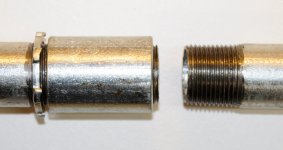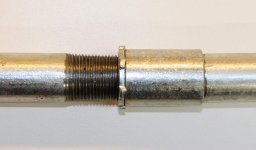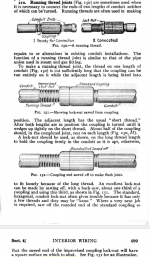You are using an out of date browser. It may not display this or other websites correctly.
You should upgrade or use an alternative browser.
You should upgrade or use an alternative browser.
Rmc
- Thread starter Djelite
- Start date
- Status
- Not open for further replies.
- Location
- Bremerton, Washington
- Occupation
- Master Electrician
I wold say yes on your reason.
I once used an electrical coupling in place of a plumbing coupling…when I first started as a maintenance man (it leaked)
I once used an electrical coupling in place of a plumbing coupling…when I first started as a maintenance man (it leaked)
- Location
- New Jersey
- Occupation
- Journeyman Electrician (retired)
I'm not so sure that the taper has anything to do with it. When using the coupling at the running thread the RMC is weakened. Back in the day when everything was RMC this was called a depression coupling because 3-piece couplings (Erickson's) were too expensive. Looked like this "depression coupling":Article 344 states that couplings arent allowed with running threads. I understand this is due to not being able to adequately tighten both sides. Does it also has to do withe that fact the coupling isnt tappered and conduit is?


qcroanoke
Sometimes I don't know if I'm the boxer or the bag
- Location
- Roanoke, VA.
- Occupation
- Sorta retired........
I may have done that when supply house was 40 miles away and i needed to get it done
- Location
- Bremerton, Washington
- Occupation
- Master Electrician
Sounds reasonable. A lot of the whys are lost to history.I'm not so sure that the taper has anything to do with it. When using the coupling at the running thread the RMC is weakened. Back in the day when everything was RMC this was called a depression coupling because 3-piece couplings (Erickson's) were too expensive. Looked like this "depression coupling":
View attachment 2559989View attachment 2559990
synchro
Senior Member
- Location
- Chicago, IL
- Occupation
- EE
I'm not so sure that the taper has anything to do with it. When using the coupling at the running thread the RMC is weakened. Back in the day when everything was RMC this was called a depression coupling because 3-piece couplings (Erickson's) were too expensive. Looked like this "depression coupling"
Labor was cheaper way back too.
In this excerpt from the 1914 American Electrician's Handbook they show the use of a cut off section of another coupling instead of a normal locknut to make the joint a little more rigid. But it's still weakened compared to a full taper on the conduit.
The extra cost of an Erickson was also mentioned in the book as you've indicated.

Awesome.Labor was cheaper way back too.
In this excerpt from the 1914 American Electrician's Handbook they show the use of a cut off section of another coupling instead of a normal locknut to make the joint a little more rigid. But it's still weakened compared to a full taper on the conduit.
The extra cost of an Erickson was also mentioned in the book as you've indicated.
View attachment 2559991
the threads , the conduits smaller , at the threads I mean .Article 344 states that couplings arent allowed with running threads. I understand this is due to not being able to adequately tighten both sides. Does it also has to do withe that fact the coupling isnt tappered and conduit is?
kwired
Electron manager
- Location
- NE Nebraska
- Occupation
- EC
The "running thread" portion is not tapered, and is consistent OD until you get to where it starts to taper. It will not tighten in the side with running thread other than should you put a jam nut on it or let it bottom out, but only takes slight turning and it is just as loose as if you made three full turns. With tapered thread in the socket once it starts to tighten up, it always has a reasonable amount of contact to assure fair electrical continuity. Wrench tight isn't really a torque spec, but kind of has some unwritten acceptable variance to it and could easily be acceptably tight enough even though is fairly easy to get another turn or two out of it.the threads , the conduits smaller , at the threads I mean .
Sounds reasonable. A lot of the whys are lost to
The running threads arent tappered and neither is the coupling threads, right?The "running thread" portion is not tapered, and is consistent OD until you get to where it starts to taper. It will not tighten in the side with running thread other than should you put a jam nut on it or let it bottom out, but only takes slight turning and it is just as loose as if you made three full turns. With tapered thread in the socket once it starts to tighten up, it always has a reasonable amount of contact to assure fair electrical continuity. Wrench tight isn't really a torque spec, but kind of has some unwritten acceptable variance to it and could easily be acceptably tight enough even though is fairly easy to get another turn or two out of it.
- Location
- New Jersey
- Occupation
- Journeyman Electrician (retired)
That's correct, only the last portion of the running thread is tapered (farthest from the end) which the normal thread length. Electrical couplings are not tapered.The running threads arent tappered and neither is the coupling threads, right?
- Status
- Not open for further replies.

